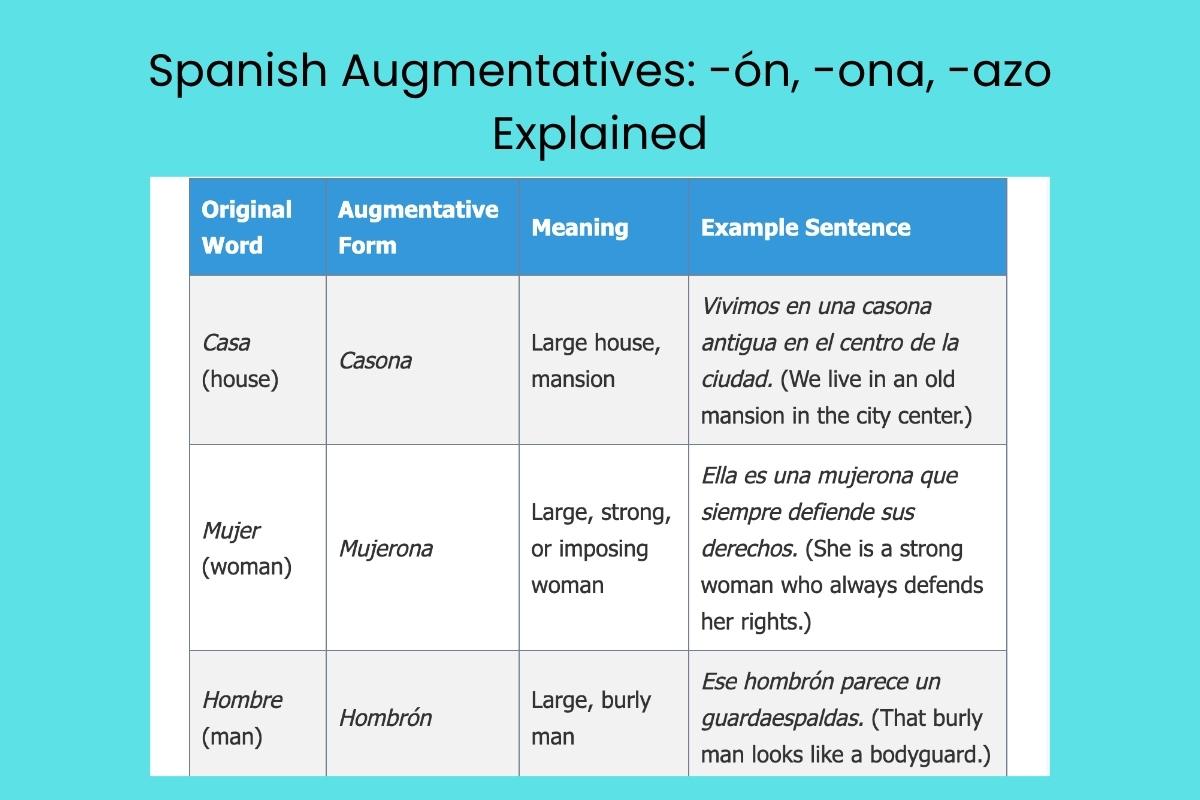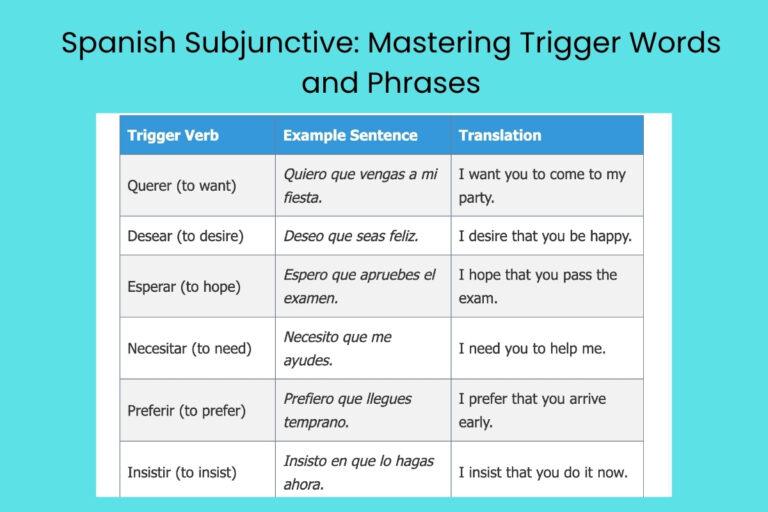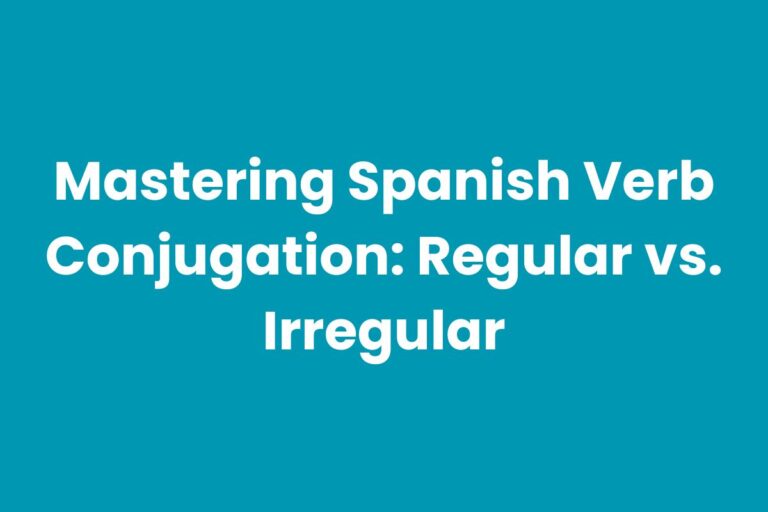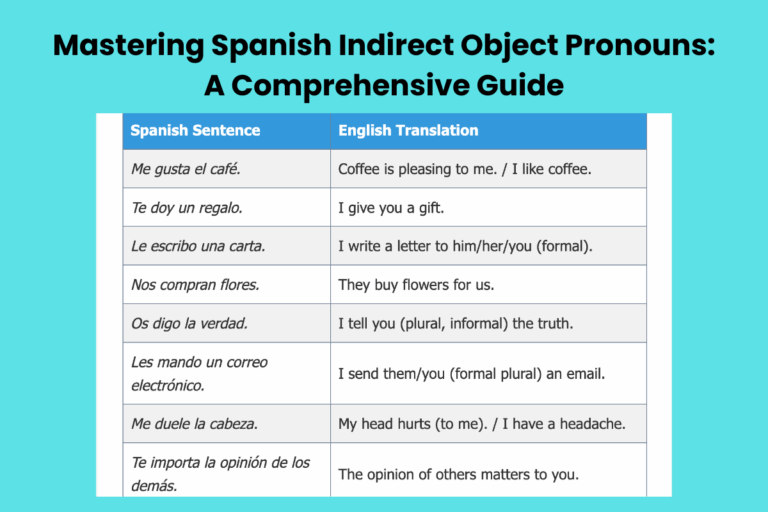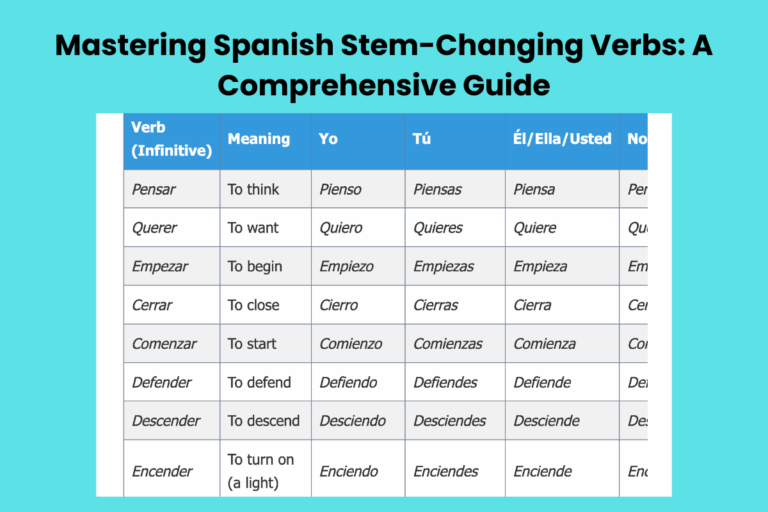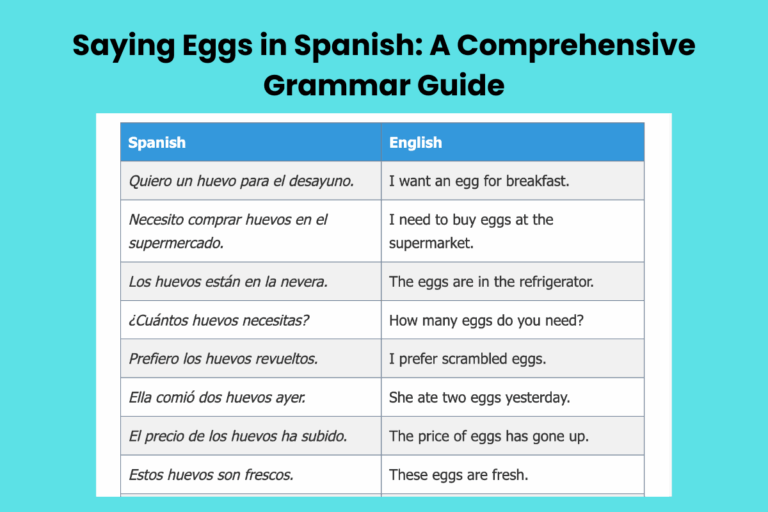Spanish Augmentatives: -ón, -ona, -azo Explained
Augmentatives in Spanish, signified by suffixes like -ón, -ona, and -azo, dramatically alter the meaning of words, typically indicating a larger size, intensity, or even a pejorative sense. Mastering these suffixes is crucial for understanding nuances in spoken and written Spanish, avoiding misinterpretations, and enriching one’s expressive capabilities.
This article delves into the intricacies of augmentatives, providing comprehensive explanations, copious examples, and practical exercises. This guide is ideal for Spanish learners of all levels, from beginners seeking to expand their vocabulary to advanced students aiming to refine their command of the language.
Table of Contents
- Definition of Spanish Augmentatives
- Structural Breakdown of Augmentatives
- Types and Categories of Augmentatives
- Examples of Augmentatives
- Usage Rules for Augmentatives
- Common Mistakes with Augmentatives
- Practice Exercises
- Advanced Topics in Augmentatives
- Frequently Asked Questions
- Conclusion
Definition of Spanish Augmentatives
Augmentatives are suffixes added to the end of words in Spanish to indicate an increase in size, intensity, or degree. They can also sometimes convey a sense of clumsiness, humor, or even a negative connotation depending on the context. The most common augmentative suffixes are -ón, -ona, and -azo (and their feminine forms -aza). It’s important to note that augmentatives don’t always simply mean “bigger”; they often add emotional or subjective weight to the word.
The function of augmentatives extends beyond mere size indication. They can modify the emotional impact of a word, adding emphasis or expressing an attitude. For example, saying “casa” (house) is neutral, but “casona” implies a large, potentially impressive house. The context is crucial in determining whether the augmentative is used literally or figuratively. Sometimes, an augmentative can even completely change the meaning of a word, creating a new term with its own distinct definition. Understanding these nuances is vital for mastering the Spanish language.
Augmentatives are used in a variety of contexts in Spanish, from casual conversations to formal writing. They appear frequently in descriptive passages, narratives, and even humorous anecdotes.
Recognizing and understanding augmentatives allows you to appreciate the subtleties of the language and communicate more effectively. Furthermore, being able to use augmentatives appropriately demonstrates a higher level of fluency and linguistic awareness.
Ignoring them can lead to misunderstandings or misinterpretations of the speaker’s intent.
Structural Breakdown of Augmentatives
The structure of augmentatives is relatively straightforward. They are formed by adding a suffix to the root of a word.
However, some spelling changes may occur to maintain pronunciation rules. Let’s break down the process:
- Identify the root word: This is the base form of the word to which you’ll add the augmentative suffix. For example, in the word “palabra” (word), the root is “palabr-“.
- Choose the appropriate suffix: The most common suffixes are -ón, -ona, and -azo. The choice depends on the gender and ending of the original word, as well as the desired nuance.
- Apply any necessary spelling changes: Sometimes, you’ll need to adjust the spelling to maintain the correct pronunciation. For example, if the root word ends in “-c“, it often changes to “-qu” before adding the suffix.
- Combine the root and the suffix: This creates the augmentative form of the word.
For example, consider the word “libro” (book). To form the augmentative, we identify the root “libr-“. Then, we add the suffix “-ón” to get “librón“. This word can mean a large book or, figuratively, someone who studies a lot.
Another example, “mujer” (woman). To form the augmentative, we identify the root “mujer-“. Then, we add the suffix “-ona” to get “mujerona“. This word implies a big, strong, or imposing woman.
Let’s look at an example using –azo, “golpe” (hit/blow), the root “golp-“. Adding –azo, we get “golpazo,” meaning a big hit or blow.
Types and Categories of Augmentatives
While the primary function of augmentatives is to indicate an increase in size or intensity, they can be categorized based on the specific nuance they convey:
1. Augmentatives of Size
These are the most straightforward type, indicating that something is physically larger than normal. For example, “casa” (house) becomes “casona” (large house).
2. Augmentatives of Intensity
These augmentatives amplify the quality or characteristic described by the word. For instance, “frio” (cold) becomes “friazo” (very cold). The -azo suffix often conveys a sudden or intense feeling.
3. Pejorative Augmentatives
In some cases, augmentatives can have a negative connotation, implying clumsiness, ugliness, or disapproval. For example, “hombre” (man) could become “hombrón“, which can sometimes imply a large, boorish man.
4. Humorous Augmentatives
Augmentatives can also be used humorously to exaggerate a situation or characteristic. This is often done playfully and without any negative intent. An example is “nariz” (nose) becoming “narizota” (big nose), used in a teasing or affectionate way.
5. Augmentatives with Changed Meaning
Sometimes, the augmentative form takes on a completely new and distinct meaning from the original word. For example, “caja” (box) becomes “cajón” (drawer).
Examples of Augmentatives
Here are several examples of augmentatives, organized by the suffix used, to illustrate their various uses and meanings. These examples will help you understand how augmentatives function in context and how they can alter the meaning and emotional impact of a word.
Examples with -ón / -ona
The suffixes -ón and -ona are among the most common augmentative suffixes in Spanish. They are typically used to indicate a larger size, but can also carry connotations of clumsiness, impressiveness, or even negativity depending on the context.
The following table provides a comprehensive list of examples using these suffixes.
| Original Word | Augmentative Form | Meaning | Example Sentence |
|---|---|---|---|
| Casa (house) | Casona | Large house, mansion | Vivimos en una casona antigua en el centro de la ciudad. (We live in an old mansion in the city center.) |
| Mujer (woman) | Mujerona | Large, strong, or imposing woman | Ella es una mujerona que siempre defiende sus derechos. (She is a strong woman who always defends her rights.) |
| Hombre (man) | Hombrón | Large, burly man | Ese hombrón parece un guardaespaldas. (That burly man looks like a bodyguard.) |
| Libro (book) | Librón | Large book, tome | Necesito un librón para mi investigación. (I need a large book for my research.) |
| Película (movie) | Peliculón | Great movie, blockbuster | La nueva película de Marvel es un peliculón. (The new Marvel movie is a blockbuster.) |
| Coche (car) | Cochazo | Fancy or expensive car | Se compró un cochazo deportivo. (He bought a fancy sports car.) |
| Problema (problem) | Problemón | Big problem | Tenemos un problemón con el nuevo proyecto. (We have a big problem with the new project.) |
| Palabra (word) | Palabrota | Curse word | El niño dijo una palabrota y su madre lo regañó. (The boy said a curse word and his mother scolded him.) |
| Taza (cup) | Tazón | Bowl | Me gusta tomar el cereal en un tazón grande. (I like to eat cereal in a large bowl.) |
| Isla (island) | Islote | Small island | Vimos un islote rocoso en medio del mar. (We saw a rocky islet in the middle of the sea.) |
| Voz (voice) | Vozarrón | Loud, booming voice | El cantante tiene un vozarrón impresionante. (The singer has an impressive booming voice.) |
| Camisa (shirt) | Camisón | Nightgown | Ella se puso un camisón de seda para dormir. (She put on a silk nightgown to sleep.) |
| Nariz (nose) | Narizón | Large nose | El payaso tenía una narizona roja. (The clown had a big red nose.) |
| Ojo (eye) | Ojazos | Big, beautiful eyes | La niña tiene unos ojazos azules. (The girl has big blue eyes.) |
| Cuchillo (knife) | Cuchillón | Large knife | El carnicero usó un cuchillón para cortar la carne. (The butcher used a large knife to cut the meat.) |
| Gato (cat) | Gatazo | Very big cat, or a lucky event | Nos sacamos un gatazo en la lotería. (We had a lucky event in the lottery.) |
| Silla (chair) | Sillón | Armchair, large chair | Me senté en el sillón para leer un libro. (I sat on the armchair to read a book.) |
| Beso (kiss) | Besazo | Big kiss | Te mando un besazo enorme. (I send you a huge kiss.) |
| Juego (game) | Juegazo | Great game | El nuevo videojuego es un juegazo. (The new video game is a great game.) |
| Golpe (hit) | Golpazo | Big hit | Se dio un golpazo contra la pared. (He took a big hit against the wall.) |
Examples with -azo / -aza
The suffix -azo (and its feminine form -aza) often indicates a sudden or intense action, a large impact, or a striking resemblance. It can also be used to express surprise or admiration.
Here’s a table with a variety of examples using -azo and -aza.
| Original Word | Augmentative Form | Meaning | Example Sentence |
|---|---|---|---|
| Golpe (hit, blow) | Golpazo | Big hit, strong blow | Se cayó y se dio un golpazo en la cabeza. (He fell and hit his head hard.) |
| Puerta (door) | Portazo | Slamming of a door | Salió de la habitación dando un portazo. (He left the room, slamming the door.) |
| Brazo (arm) | Brazazo | Strong arm movement, stroke (in swimming) | El nadador dio un brazazo potente y ganó la carrera. (The swimmer made a powerful stroke and won the race.) |
| Rodilla (knee) | Rodillazo | Knee hit | Le dio un rodillazo sin querer. (He accidentally kneed him.) |
| Cabeza (head) | Cabezazo | Headbutt, header (in soccer) | El jugador marcó un gol de cabezazo. (The player scored a goal with a header.) |
| Ojo (eye) | Ojazos | Large, beautiful eyes (same as -ón, but -azo emphasizes beauty) | Tenía unos ojazos verdes que hipnotizaban. (She had mesmerizing big green eyes.) |
| Cuchillo (knife) | Cuchillada | Knife stab | Recibió una cuchillada en el brazo. (He received a knife stab in the arm.) |
| Pistola (gun) | Pistolazo | Gunshot | Se escuchó un pistolazo en la calle. (A gunshot was heard in the street.) |
| Silla (chair) | Sillazo | Hitting someone with a chair | En la pelea, le dieron un sillazo. (In the fight, he was hit with a chair.) |
| Manzana (apple) | Manzanazo | Hitting someone with an apple | Le lanzó un manzanazo durante la clase. (He threw an apple at him during class.) |
| Madre (mother) | Madraza | Great mother | Mi madre es una madraza. (My mother is a great mom.) |
| Padre (father) | Padrazo | Great father | Mi padre es un padrazo. (My father is a great dad.) |
| Sueño (dream) | Sueñazo | Great dream | Tuve un sueñazo anoche. (I had a great dream last night.) |
| Amigo (friend) | Amigazo | Great friend | Eres un amigazo. (You are a great friend.) |
| Coche (car) | Cochazo | Fancy car | Se compró un cochazo deportivo. (He bought a fancy sports car.) |
| Película (movie) | Peliculazo | Great movie | La película nueva es un peliculazo. (The new movie is a great movie.) |
| Tiro (shot) | Tirazo | Great shot | Hizo un tirazo en el partido. (He made a great shot in the game.) |
| Abrazo (hug) | Abrazazo | Big hug | Te mando un abrazazo. (I send you a big hug.) |
| Beso (kiss) | Besazo | Big kiss | Te mando un besazo enorme. (I send you a huge kiss.) |
| Frío (cold) | Fríozo | Very cold | Hace un fríozo hoy. (It’s very cold today.) |
Examples with -ote / -ota
The suffixes -ote and -ota also signify augmentatives, often conveying a sense of largeness, clumsiness, or endearment. They are less common than -ón, -ona, and -azo but still important to recognize.
They often have a slightly softer or more affectionate connotation than the other augmentatives.
| Original Word | Augmentative Form | Meaning | Example Sentence |
|---|---|---|---|
| Casa (house) | Casota | Large house | Tienen una casota en las afueras. (They have a large house in the suburbs.) |
| Perro (dog) | Perrote | Big dog | Tenemos un perrote en casa. (We have a big dog at home.) |
| Hombre (man) | Hombrote | Big, strong man | Es un hombrote muy simpático. (He’s a very nice big, strong man.) |
| Mesa (table) | Mesota | Large table | Necesitamos una mesota para el comedor. (We need a large table for the dining room.) |
| Coche (car) | Cochote | Big car | Tienen un cochote familiar. (They have a big family car.) |
| Voz (voice) | Vozota | Loud voice | Tiene una vozota que se escucha en todo el teatro. (He has a loud voice that can be heard throughout the theater.) |
| Libro (book) | Librote | Large book | Compré un librote de historia. (I bought a large history book.) |
| Nariz (nose) | Narizota | Big nose | El payaso tenía una narizota roja. (The clown had a big red nose.) |
| Ojo (eye) | Ojote | Big eye (less common) | El cíclope tenía un ojote en la frente. (The cyclops had one big eye on his forehead.) |
| Boca (mouth) | Bocota | Big mouth | ¡Cierra esa bocota! (Shut that big mouth!) |
| Risa (laughter) | Risota | Loud laughter | Soltó una risota que resonó en la sala. (He let out a peal of laughter that echoed in the room.) |
| Susto (fright) | Sustote | Big fright | Me llevé un sustote cuando vi la sombra. (I got a big fright when I saw the shadow.) |
| Gato (cat) | Gatote | Big cat | Ese gatote siempre está durmiendo. (That big cat is always sleeping.) |
| Niño (boy) | Niñote | Big boy (often used affectionately or humorously) | Ya eres un niñote, debes comportarte. (You’re a big boy now, you should behave.) |
| Flor (flower) | Florota | Big flower | Le regaló una florota roja. (He gave her a big red flower.) |
| Pelo (hair) | Pelote | Big patch of hair (less common, can be used humorously) | Tenía un pelote en la cabeza. (He had a big patch of hair on his head.) |
| Viento (wind) | Vientote | Strong wind | Hay un vientote afuera. (There’s a strong wind outside.) |
| Barco (boat) | Barcote | Big boat | Vimos un barcote en el puerto. (We saw a big boat in the port.) |
| Cama (bed) | Camota | Big bed | Compramos una camota nueva. (We bought a new big bed.) |
| Fiesta (party) | Fiestota | Big party | Organizamos una fiestota para su cumpleaños. (We organized a big party for his birthday.) |
Usage Rules for Augmentatives
Using augmentatives correctly involves understanding a few key rules:
- Gender Agreement: Augmentative suffixes must agree in gender with the noun they modify. Use -ón for masculine nouns and -ona for feminine nouns. For -azo, determine the gender of the original noun and use -azo/-aza accordingly.
- Spelling Changes: Be aware of necessary spelling changes to maintain pronunciation. For example, ‘c’ often changes to ‘qu’ before -ón (e.g., flaco becomes flacquito – a diminutive, but the principle applies).
- Context is Key: The meaning of an augmentative can vary greatly depending on the context. Pay attention to the surrounding words and the overall tone of the conversation.
- Not all words can be augmented: Some words simply don’t lend themselves to augmentation. Attempting to augment them can sound unnatural or nonsensical.
- Subjectivity: The use of augmentatives is often subjective and depends on the speaker’s perspective and intentions.
Exceptions: There are always exceptions to the rules! Some words have irregular augmentative forms that must be memorized. Additionally, some augmentatives have become standard words with their own unique meanings, diverging from the simple “bigger” definition.
Common Mistakes with Augmentatives
Here are some common mistakes to avoid when using augmentatives:
| Incorrect | Correct | Explanation |
|---|---|---|
| Casaón | Casona | Casa is feminine, so the augmentative should be casona. |
| Golpeza | Golpazo | While *golpe* is masculine, *golpazo* is the correct, established augmentative form. |
| Problemota | Problemón | Problema is masculine, so the augmentative should be problemón. |
| Using an augmentative when a different word exists. | Using the correct word | Instead of trying to augment a word to mean drawer, just use *cajón*. |
| Applying augmentatives to words that don’t accept them. | Rephrasing the sentence. | Some words sound unnatural with augmentatives. Find another way to express the idea. |
Another common mistake is using augmentatives excessively. While they can add emphasis and expressiveness, overuse can make your speech sound unnatural or even comical.
Practice Exercises
Test your understanding of augmentatives with these exercises.
Exercise 1: Choose the Correct Augmentative
Select the correct augmentative form for each word.
| Question | Options | Answer |
|---|---|---|
| 1. Libro | a) Librazo b) Librón c) Librote | b) Librón |
| 2. Mujer | a) Mujerzo b) Mujerón c) Mujerota | b) Mujerón |
| 3. Golpe | a) Golpón b) Golpazo c) Golpote | b) Golpazo |
| 4. Casa | a) Cazón b) Casazo c) Casona | c) Casona |
| 5. Perro | a) Perrazo b) Perrón c) Perrote | c) Perrote |
| 6. Amigo | a) Amigazo b) Amigón c) Amigote | a) Amigazo |
| 7. Voz | a) Voza b) Vozón c) Vozarrón | c) Vozarrón |
| 8. Ojo | a) Ojazo b) Ojote c) Ojoon | a) Ojazo |
| 9. Coche | a) Cochazo b) Cochón c) Cochote | a) Cochazo |
| 10. Padre | a) Padrote b) Padrazo c) Padrón | b) Padrazo |
Exercise 2: Fill in the Blanks
Complete the sentences with the appropriate augmentative form of the word in parentheses.
| Question | Answer |
|---|---|
| 1. Viven en una ___________ (casa) enorme. | Casona |
| 2. ¡Qué ___________ (golpe) se dio! | Golpazo |
| 3. Es un ___________ (amigo) de verdad. | Amigazo |
| 4. Tiene unos ___________ (ojo) preciosos. | Ojazos |
| 5. El cantante tiene un ___________ (voz) impresionante. | Vozarrón |
| 6. Compré un ___________ (libro) muy interesante. | Librón |
| 7. Se compró un ___________ (coche) nuevo. | Cochazo |
| 8. ¡Qué ___________ (susto) me diste! | Sustote |
| 9. Es una ___________ (mujer) muy fuerte. | Mujerona |
| 10. Le di un ___________ (abrazo) muy fuerte. | Abrazazo |
Advanced Topics in Augmentatives
For advanced learners, consider these more complex aspects of augmentatives:
- Regional Variations: The usage and connotation of augmentatives can vary significantly between different Spanish-speaking regions.
- Subjective Interpretation: The emotional impact of an augmentative is highly subjective and can be influenced by cultural factors and personal experiences.
- Literary Uses: Augmentatives are often used in literature to create vivid imagery, evoke emotions, and develop characters.
- Historical Evolution: The meanings and usages of augmentatives have evolved over time, reflecting changes in society and culture.
Exploring these advanced topics will deepen your understanding of augmentatives and enhance your ability to use them effectively in a variety of contexts. It requires immersing yourself in authentic Spanish content, paying close attention to how native speakers use augmentatives in different situations.
Frequently Asked Questions
- What is the difference between -ón and -azo?
While both are augmentative suffixes, -ón typically indicates size or impressiveness, while -azo often implies a sudden action, impact, or striking resemblance. The choice depends on the specific nuance you want to convey.
- Can any word be made into an augmentative?
No. Some words simply don’t lend themselves to augmentation and attempting to do so can sound unnatural. Context and common usage dictate which words can be augmented.
- Do augmentatives always mean something is bigger?
No. While size is a common meaning, augmentatives can also indicate intensity, clumsiness, humor, or even have a negative connotation. The context is crucial for interpretation.
- Are augmentatives used in all Spanish-speaking countries?
Yes, but the specific usage and connotation can vary between different regions. Some augmentatives may be more common or have slightly different meanings in certain countries.
- How can I learn to use augmentatives correctly?
The best way to learn is through exposure to authentic Spanish content, such as books, movies, and conversations with native speakers. Pay attention to how augmentatives are used in different contexts and practice using them yourself.
- Is it possible to overuse augmentatives?
Yes. While they can add emphasis and expressiveness, overuse can make your speech sound unnatural or even comical. Use them sparingly and appropriately.
- What are some common mistakes to avoid when using augmentatives?
Common mistakes include incorrect gender agreement, forcing augmentatives onto words that don’t accept them, and misinterpreting the nuance conveyed by the augmentative.
- Can augmentatives change the meaning of a word completely?
Yes, in some cases, the augmentative form takes on a completely new and distinct meaning from the original word. For example, “caja” (box) becomes “cajón” (drawer).
- What is the difference between augmentatives and diminutives?
Augmentatives increase the size, intensity, or degree of something, while diminutives decrease it. Diminutives often convey affection or smallness (e.g., -ito, -ita).
- Are there any resources I can use to practice augmentatives?
Many online resources offer exercises and quizzes on augmentatives. You can also find examples in Spanish textbooks, novels, and online articles. Practice using them in conversations with native speakers to get feedback.
Conclusion
Mastering Spanish augmentatives is a valuable step towards achieving fluency and a deeper understanding of the language. While they may seem daunting at first, with practice and attention to detail, you can learn to use them effectively to enhance your communication skills.
Remember to pay attention to gender agreement, spelling changes, and the context in which the augmentative is used. By avoiding common mistakes and
use authentic Spanish materials, you’ll be well on your way to mastering this important aspect of Spanish grammar.

